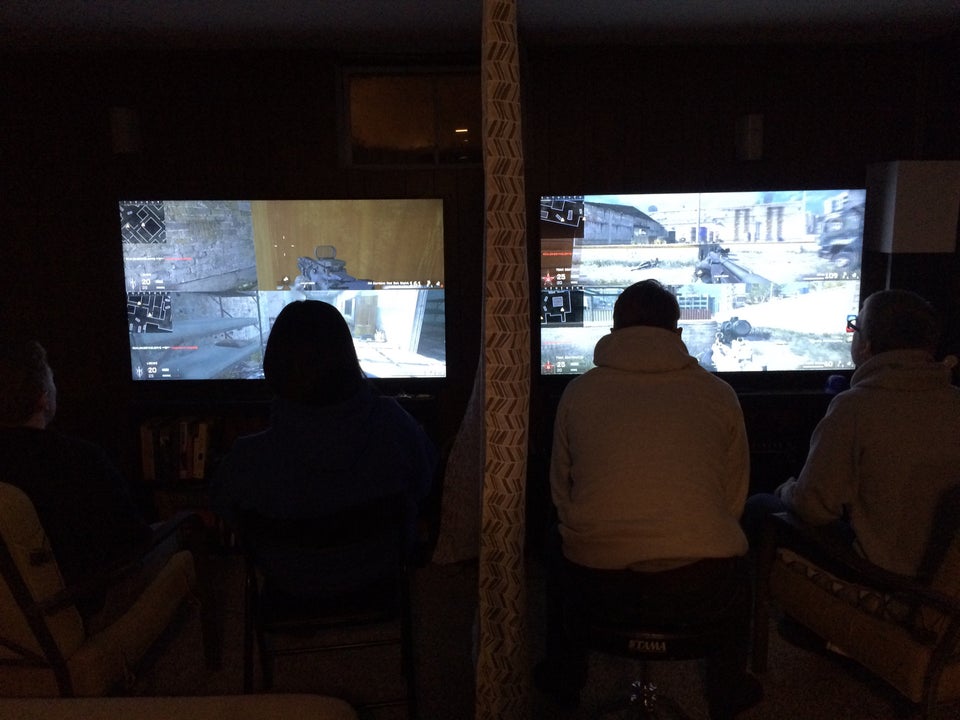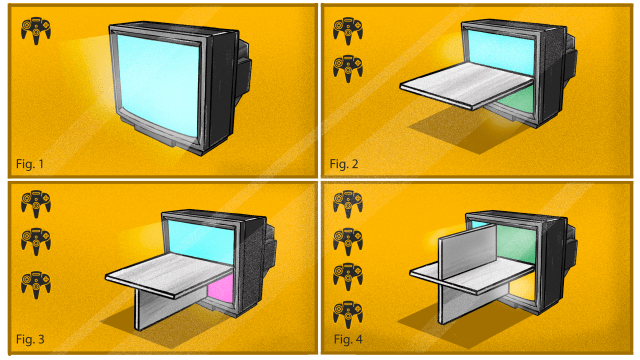Every couple of years, someone on the internet demonstrates how they adjudicate screen cheating. Two kids tape a Toy Story blanket to their TV, ensuring an airtight barrier between both halves of the CRT display. One player stands up in the middle of a Halo deathmatch, while his two friends are condemned to their own MacGyvered pods. Never again shall they be victimised by a dubious plasma grenade. Another group came up with the same mechanism. I imagine nothing feels worse to game with than a flap of cardboard resting on your head.
As a child of the ‘90s, and therefore someone who grew up playing a lot of splitscreen multiplayer, I too sometimes dreamed of enforcing the anticheat measures that have been documented online for generations. Screen-peeking is a scourge. Hiding spots, deadly angles, and perfectly timed flanks all can be neutralised by someone who’s keeping an eye on your HUD. You can never take them by surprise, and they always seem to get the jump on you. For years, it was the crutch for everyone when plans went awry. There is no better way to recoup dignity than by blaming a terrible shot or a foolish gambit on your brother spoiling the moment by spying on your quadrant of the TV. And yet, there never seemed to be any great recourse to solve that problem without a lot of sweat and a lot of tape.
Of course, I never fastened some sort of thing to the display in order to stymie the cheeky swindlers. The reasons for that are obvious: I didn’t want my parents to yell at me, and I didn’t want to accidentally destroy the TV. But for as long as I’ve been online, I’ve marveled at the industrious players who’ve shared their own barriers and obstructions in order to make their home games a little bit more fair. As I quickly learned from my interviews, in order to muster up the courage to convert your living room into an amateur esports arena, you must first get really, really annoyed at someone you love.
Timesplitters 2 was one of the preeminent splitscreen games of the early 2000s, and if you are a veteran of Eidos’ legendary first-person shooter, you might remember a map called Chasm, which was split across two fortified bases and usually devolved into players taking potshots at each other from across no man’s land. An environment like that is ripe for the dreaded screen-peek.
It became clear after 34-year old Andrew Millington’s friend evaded a frame-perfect headshot in the early 2000s that treachery was afoot. “He giggled uncontrollably [after dodging,]” he says. “I knew what happened.”
And so, Millington took matters into his own hands. His family had one of those old, stocky rear-projection TVs, which meant that there was a lot of leftover cardboard from the unboxing. He cut a slit partway through two chunky rectangles and shunted them together, in the same way you and I might connect the wings to the body of a styrofoam plane. He solidified the joints of his contraption with duct tape, and then mounted it to the screen of his television with even more tape, until he was sure it wasn’t going to fall off. Voila! Every player at the Timesplitters derby was now condemned to their own corner of the screen — any lingering eyes would be met with the punitive force of packaging material. Gamer blinders, if you will.
“Taking it off and putting it back on required new tape at the top and sides every time,” says Millington. “My stepdad was less than pleased.”
There is a certain trashlord decadence to these screen-narrowing rigs that I’ve always respected. A 41-year old in Winnipeg, also named Andrew, never played on a barrier himself, but says that a friend who took Goldeneye and Perfect Dark “very seriously” fashioned one out of old pizza boxes. Quite frankly, you can illustrate a huge demographic of gamer culture in the image of four friends sitting around a dorm room at the witching hour, on their upteempth deathmatch, converting the shells that used to house their pepperoni-and-onions to seal off the corridors of Facility as best they can. “In the games I played in, we always used Phil’s barrier as a threat, but were too lazy to actually build one ourselves,” says Andrew.
“To make it work, the players needed to sit near the screen close enough that they could see their quadrant,” he adds. “I think a larger CRT screen was involved, likely with a few people sitting on the floor and the upper screen folk standing or sitting in chairs.”
That lines up with Millington’s design. He had two friends on barstools, chilling behind those that were stuck with the bottom half of the screen. “Essentially, everyone was fully isolated,” he says. All together, he says that his cardboard job did add to the competitive integrity around the PS2. No longer was anyone forced to contend with the tyranny of questionable feints. “You couldn’t have asked for a better solution as a scavenging teenager,” he says.

Of course, splitscreeners didn’t exclusively use abandoned food containers or discarded Best Buy packaging to create their buffer zone. Bobby Olsen, a 23-year old from Nebraska, flaunted an ingenious set-up for his Modern Warfare Remastered LAN sessions on Reddit three years ago. A quilt, nailed to the ceiling by thumbtacks, wilts down between a pair of televisions and two sets of gamers — creating insulated booths with no potential for corner-of-the-eye flanking. “It actually worked pretty well,” says Olsen, who claims that those Call of Duty sessions got significantly better once he started weeding out the screen-peekers. “It was a little confining, and it did nothing to prevent people from overhearing verbal call-outs, but with some clever hand signals me and my partner overcame it.”
It’s strange to think that this multiplayer problem doesn’t exist in quite the same way anymore. First-person shooters, once the default for four-player throwdowns, frequently ship with barebones splitscreen capabilities (if the feature is included at all). I attend the odd LAN party here or there — games like Smash Bros. and Street Fighter are still best experienced in person — but these days if I’m playing with friends, we’re usually on our own PCs, alone in our respective houses. The need to forage for random detritus in order to protect the sanctity of Goldeneye is unfortunately a thing of the past. In fact, screen-peeking itself has been cloaked in its own strange nostalgia. Everyone I spoke to for this story looked back on their home multiplayer games wistfully. Who would’ve thought that gamers would be capable of some sentimentality about the duct tape they used to paste onto hulking CRT TVs? Or the unadulterated anger you could summon after a little brother materialised behind you on Blood Gulch for the fifth time in a row from an impossible vector?
However, if you too ache for the days of screen-peeking — for an era where gaming together meant sharing TV real estate with each other — there is one option on Steam that speaks directly to those desires. Screencheat, which was released in 2014, features classic four-player splitscreen with an added twist: the players competing are invisible to one another. If you are to win, you must stoop to the most dishonorable lows of gamer ethos and snoop through the other three quadrants to know when to pull the trigger. Nicholas McDonnell, director of Samurai Punk, the studio behind Screencheat, says the game was inspired by his many indiscretions when playing Halo 2 with his friends. “They only discovered I was bad at the game when we started to play online and I couldn’t compete,” he says.
Perhaps that’s the final form of screen-peeking. It was once a pox that would get you ostracised at your local LAN party, but now, decades after the splitscreen heights, it’s become something of a lapsed tradition, worthy of tribute by the indie developers who grew up on it. You simply can’t get the same feeling in League of Legends or Warzone, so perhaps it is natural that we’ve begun to miss it. How beautiful it was, when the fairness of our Timesplitters matches was one of the most important things in our world.
Luke Winkie is a writer and former pizza maker from San Diego, currently living in Brooklyn. In addition to Kotaku, he contributes to Vice, PC Gamer, Playboy, Rolling Stone, and Polygon.

Leave a Reply